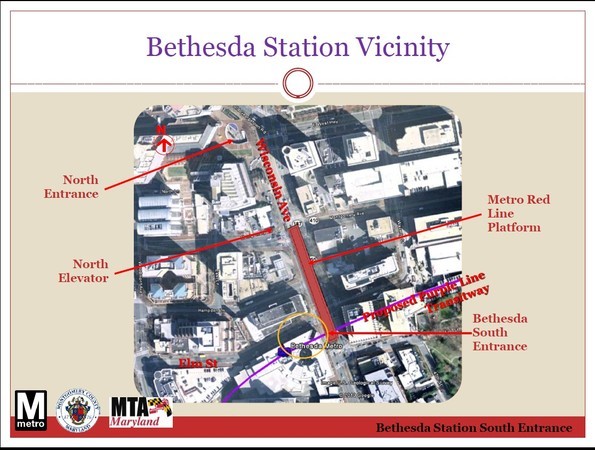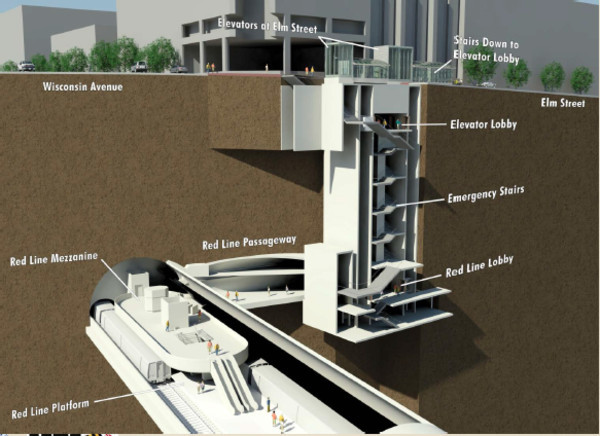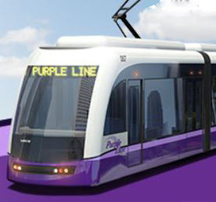Latest updates
On Feb. 11 the County Council approved a proposal to tear down the Apex Building instead of building the Bethesda Purple Line station in the old railroad tunnel beneath it. In exchange for tearing down the building, the owners of the building would be allowed to replace it with a much bigger building after the Purple Line is finished. The owners have belatedly expressed interest in the idea, but they claim they need additional payment of several million dollars from the county.
If the Apex building is replaced, elevators from the Red Line would be on the south side of the Purple Line tracks instead of the north side under Elm Street. Transfer passengers would come up to street level and take an escalator down to the platform between the two Purple Line tracks. These two drawings show how the station would work. The new design greatly improves access from the street to the Red Line (5 elevators instead of 2, and no intermediate stop) and does not make transfer passengers walk across the Purple Line tracks.
Bethesda South Metro Entrance and the Purple Line Connection
Why We Need to Build the New South Entrance to the Bethesda Metro Now
In May 2008, the Montgomery County Council voted to fund construction of a new south entrance to the Bethesda Metro which will serve as the connection between the Red Line and the future Purple Line. The Bethesda south entrance will be a bank of elevators at the corner of Wisconsin Avenue and Elm Street. The Purple Line will have its Bethesda terminus in the tunnel that goes under Wisconsin Avenue at this intersection. The elevators will stop at street level and in the tunnel, and then go down to the back end of the Metro station.

Metro has completed planning and preliminary design studies. Click here for the Study Summary, Study Main Text, and the Appendices. Design and construction are fully funded in the Montgomery County budget.
The new entrance will make the Red Line much more accessible to downtown Bethesda. The number of dwelling units within ¼ mile of a station entrance will increase by 68%, and the number of jobs will grow by 11%. Even without the Purple Line, this entrance would attract 700 additional daily trips on the Red Line at Bethesda by 2030. In addition, 9000 daily trips by people who would use the Red Line anyway will be faster because the new entrance will be closer to them.
The south entrance will also relieve congestion on the escalators that connect the train platform to the mezzanine of the existing Bethesda station entrance. If the new entrance is not constructed, congestion on the escalators will reach unacceptable levels as ridership increases over the next ten years, and a new stairway or escalator will have to be built. A second entrance will also make the station safer by providing a way out if an emergency were to block the north entrance.
Passengers will take high-speed elevators down to the Red Line, as they do at Forest Glen and at the south end of Friendship Heights. Initially, two elevators will go from the sidewalk of Elm Street down to the Red Line. When the Purple Line is built, these elevators will make a third stop in an alcove off the tunnel where the Purple Line will stop. The alcove will extend beneath Elm Street, where there will be two to four additional elevators that connect only the Purple Line and the Red Line. There will also be a stairway for emergency evacuation.

Project History
The Bethesda south entrance was in the county Master Plan even before the Purple Line. The station was built with “knock-out” panels to facilitate adding a south entrance.
In 1989, the Montgomery County Council voted to endorse light rail between Bethesda and Silver Spring. A dozen years later, this concept expanded into the Purple Line light rail from Bethesda to New Carrollton, but another decade has passed and nothing has been built while east-west commuters sit in ever-worsening traffic. Between the early 1990s and 2008, no county money was spent to help build the transit link we badly need.
In 2008, after a campaign launched by ACT triggered an outpouring of public support, the County Council appropriated $5 million for design of the south entrance and preparation of bid documents. A year later, it budgeted $55 million to cover the full cost of construction.
The design is being prepared by the Maryland Transit Administration. Work has advanced slowly because the Montgomery County Dept. of Transportation has repeatedly delayed the transfer of appropriated funds. The design is now nearing completion. At last report, no work is being done because MCDOT instructed MTA to stop work. Transit advocates see MCDOT's delaying tactics as part of a larger pattern - the agency also tried to build a highway underpass with funding for pedestrian access to the Medical Center Metro and opposed the redesign of Rockville Pike as a pedestrian-friendly boulevard.
The 2011 county budget delayed construction of the south entrance until 2015. MCDOT justifies the delay by a desire to coordinate with Purple Line construction, but in fact there is no necessity for this project to wait until the Purple Line is built. Detailed engineering design of the south entrance will be somewhat easier if all details of the Purple Line station are nailed down first, but on the other hand there could be construction management problems if both the south entrance and the station are built at the same time. Also, the complex underground construction of the south entrance may require a longer construction time than the Purple Line, so if both begin at the same time the connection to the Red Line would not be available yet when the Purple Line opens.
In 2012, County Executive Leggett again proposed deleting the new Bethesda metro entrance from the county budget. The County Council voted to keep it in. Construction is funded to begin in 2016. To pay for it, the county will delay the building of new traffic lanes on Goshen Road and Snouffer School Road, projects whose purpose is to support future sprawl development. The only councilmembers speaking against this switch were Craig Rice and Marc Elrich.
The South Entrance is Highly Cost-Effective
Even before it connects with the Purple Line, the Bethesda south entrance is comparable in cost-effectiveness to other transit investments being made in our region:
- 9000 trips × 0.1 hr/trip = 900 hours saved per day
- $60 million/900 = $66,700 per daily hour saved
This is twice as cost-effective as the Phase 1 Dulles Metrorail Extension which will save 17,800 hours per day at a cost of at least $2.6 billion:
- $2.6 billion/17,800 = $146,100 per daily hour saved

